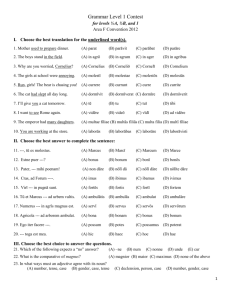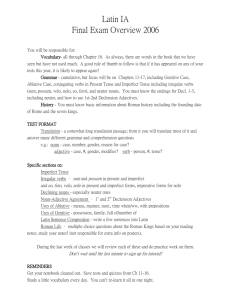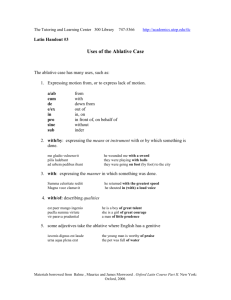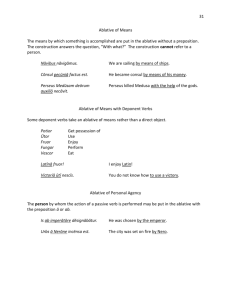Chapter 15
advertisement
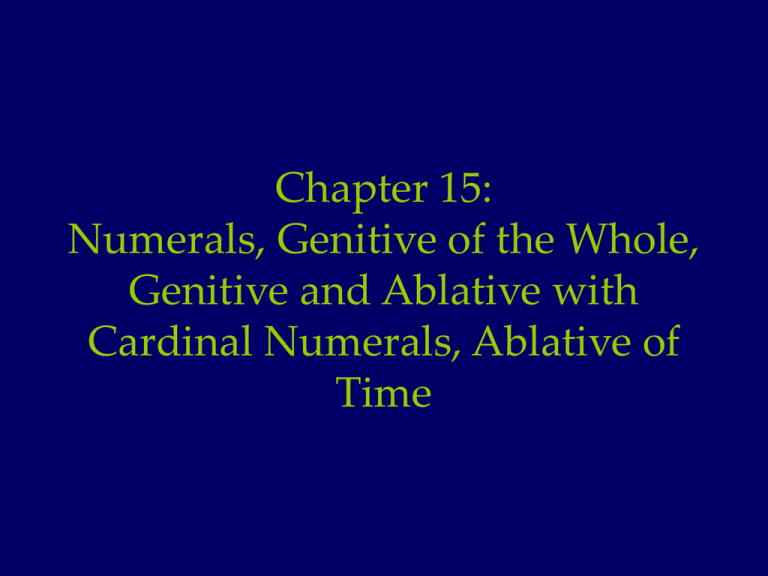
Chapter 15: Numerals, Genitive of the Whole, Genitive and Ablative with Cardinal Numerals, Ablative of Time Numerals The two most common types of numerals are - cardinal (e.g. one, two, three, etc) - ordinal (e.g. first, second, third, etc) Cardinal Numerals In Latin, all the cardinal numbers through 100 are indeclinable adjectives except for 1, 2, and 3. Unus, a, um is a special –ius adj we’ve already encountered. (See Ch 9) Cardinal Numerals Two, duo, is declined as follows. (NB there is no singular, as two is obviously plural) Masc. Nom duo Gen duorum Dat duobus Acc duos Abl duobus Fem. duae duarum duabus duas duabus Neut. duo duorum duobus duo duobus Cardinal Numerals Three, tres, is declined as follows. Note that it has an i in the genitive and an i in the neuter nominative and accusative, like 3rd Decl. i-stems. M&F Nom tres Gen trium Dat tribus Acc tres Abl tribus N tria trium tribus tria tribus Cardinal Numerals The numbers for the hundreds from 200-900 are declined like plural 1st/2nd declension adjectives. ex: ducenti, ae, a trecenti, ae, a Cardinal Numerals Mille (1,000) is an indeclinable adjective in the singular. However, in the plural (i.e. thousands) it is a neuter 3rd declension i-stem noun, milia, and declines as such. M/F/N N Nom mille milia Gen mille milium Dat mille milibus Acc mille Abl mille milibus milia Ordinal Numerals Ordinal numbers indicate sequence (first, second, third, etc). They are regular 1st/2nd declension adjectives. Ex: primus, a, um Genitive of the Whole Words that denote a part of something (e.g. much, more, many, part, enough) can be followed by a dependent genitive, which names the whole of which it is a part. This genitive is also frequently known as the Partitive Genitive. Genitive of the Whole Latin frequently uses this genitive after the neuter nominative and accusatives of certain pronouns and adjectives, including aliquid multum minus nihil quantum quid plus satis tantum nimis Genitive of the Whole It can also be the neuter singular of a second declension adjective multum boni quid novi nihil spei Genitive and Ablative with Cardinal Numerals Milia uses the partitive genitive (e.g. milia virorum – thousands of men) With all the other cardinal numbers, the idea of part from whole is expressed by using ex or de and the ablative. (e.g. duo ex fratribus) Genitive and Ablative with Cardinal Numerals Note the difference between duo fratres duo ex fratribus mille feminae milia feminarum Ablative of Time When or Within Which To express time when or within which, Latin uses the ablative case without a preposition. In English translation, we usually use a preposition such as on, in, at, or within. Ablative of Time When or Within Which Let’s look at a few examples: Eodem tempore non valebant. Paucīs horīs id faciet. Aestate otium habemus. Secundo diē in urbem vēnit. Ablative of Time When or Within Which Note that the idea of duration of time (e.g. I read the book for four hours) is NOT conveyed by the use of the ablative case!

